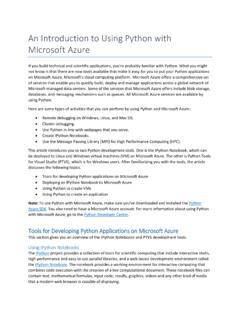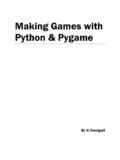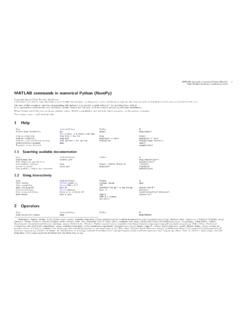Transcription of Basic Python Programming: for loops and reading files
1 DRAFT March, 2004 Ron Zacharski 3 Basic Python programming : for loops and reading files In the last tutorial we covered a range of topics including lists and how to define your own functions. In this tutorial we will continue this whirlwind introduction to Python and cover what are called for loops and also learn how to read information from files . The next tutorial, Tutorial 4, will be our easy day' a breather. In that tutorial we will go through a set of exercises that will allow you to practice and apply what you've learned. For loops Frequently we would like to perform the same actions on each element in a list that is we would like to iterate through a list performing a sequence of commands. To do this we use the for' statement, which has the following format: for name in List: command1.
2 Command2.. Here's a concrete example: >>> for noun in ['dog', 'cat', 'poodle', 'Maine Coon cat']: .. print noun .. dog cat poodle DRAFT March, 2004 Ron Zacharski Maine Coon cat The word noun' in the for noun in ' is nothing special it's just the name I made up. I could have used n', s1234', or whatever. The following all give identical results >>> for n in ['dog', 'cat', 'poodle', 'Maine Coon cat']: .. print n >>> for s1234 in ['dog', 'cat', 'poodle', 'Maine Coon cat']: .. print s1234. >>> for element_from_pet_list in ['dog', 'cat', 'poodle', 'Maine Coon cat']: .. print element_from_pet_list What is important in this example is that the name used in the for line: >>> for n in ['dog', 'cat', 'poodle', 'Maine Coon cat']: matches the name used in the print line.
3 Print n If they don't .. >>> for n in ['dog', 'cat', 'poodle', 'Maine Coon cat']: .. print noun .. Traceback (most recent call last): File "<interactive input>", line 2, in ? NameError: name 'noun' is not defined >>>. Also, you'll notice that indenting is used to delimit the block of lines associated with the for loop. (The indenting is handled automatically in the interactive window. To end the indented block enter a blank line). Let's look at another example: >>> pets = ['dog', 'cat', 'poodle', 'Maine Coon cat'] 1. >>> total = 0 2. >>> for pet in pets: 3.. length = len(pet) 4.. total = total + length 5.. print length 6.. 3. 3. 6. 14. >>> total 12. 26. DRAFT March, 2004 Ron Zacharski Here I put lines numbers on the right so I can talk about what I typed the numbers are not part of what I.
4 Typed in. line 1: We create a list named pets'. line 2: We create a name total' with the value 0. line 3: The start of the for loop. We are iterating through the list pets, each element of the list is in turn given the name pet. That is, the first time through the loop pet equals dog', the second time through the loop pet equals cat', and so on. We loop through the indented block of code for each item in the pets list. After we process the last item, Maine Coon cat' we exit the loop. lines 4 & 5: We set the name length to the length of whatever string is named pet'. For example, the first time through the loop The value of pet is dog' and the length of dog' is 3. Line 5 is .. total = total + length The first time through the loop the value of total is 0 and the value of length is 3 so the following substitution takes place.
5 Total = total + length | |.. total = 0 + 3. Now total equals 3. the second time through the loop The value of pet is cat' and the length of cat' is 3. Line 5 is .. total = total + length The value of total is currently 3 (from the length of dog') and the value of length is 3 so the following substitution takes place: .. total = total + length | |.. total = 3 + 3. Now total equals 6. the third time through the loop The value of pet is poodle'. The new value of total equals the old value (6) plus the length of poodle' (6). Now total equals 12. the fourth time through the loop The value of pet is Maine Coon cat'. The new value of total equals the old value (12) plus the length of Maine Coon cat'' (14). Now total equals 26. DRAFT March, 2004 Ron Zacharski line 6: We print the value of length.
6 The first time through the loop we print the length of dog', the next time cat', etc.). As you can see in line 12, the value of total after the for loop is 26. Let's define a function, big_length, that does a similar thing: def big_length(alist): """add the length of all the strings in the list""". total = 0. for item in alist: total = total + len(item). return total To perform the function big_length with the argument alist: def big_length(alist): First create the name total' with the value zero total = 0. Then for every item in alist: for item in alist: Set the new value of total to be the old total = total + len(item). value of total plus the length of each item Finally, return the value of total return total Here's an example of big_length's behavior: >>> big_length(pets).
7 26. >>> big_length(['apples', 'bananas']). 13. Let's define another function that uses a for loop: def print_list(alist): """print each element of a list one per line""". for item in alist: print item This time, just for practice, we'll define the function in a new program window. Save the program and then run it. The result of running it will be that the Python interpreter will now have a definition for print_list'. We can try the function using the PythonWin Interactive Window: >>> print_list(pets). dog cat poodle Maine Coon cat >>> grades = [92, 87, 91, 96, 100, 95]. >>> print_list(grades). 92. 87. 91. 96. 100. 95. >>> print_list(['Ann', 'Ben', 'Clara', 'Sara']). DRAFT March, 2004 Ron Zacharski Ann Ben Clara Sara >. Exercise The Average Can you write a function, average, that will give the average of a list of numbers?
8 >>> grades = [92, 87, 91, 96, 100, 95]. >>> average(grades). 93. >>> grades2 = [67, 75, 82, 78, 83]. >>> average(grades2). 77. To see one solution, see the solution section at the end of this chapter. reading files Learning to program requires not only learning different statements but also learning little scripts (sequences of statements). In this way you can construct your program from large building blocks instead of laboring over it line by line. A script that is particularly useful is one for reading files . The Basic template of this looks like this in English: open a file for reading read information from it close the file In Python it looks like this: infile = open(infilename, 'r'). lines = list(infile). (). Let's look at these lines one by one.
9 Opening the file The first line calls the function, open. This function takes two arguments: the name of file to open, and the mode of the file. By mode' we mean that we can open a file for reading or we can open it for writing. In this case we want to read information from a file so the mode is r' (for read'). The name of the file is a string and it represents the name of the file including possibly the path to that file. DRAFT March, 2004 Ron Zacharski For example, suppose I have a folder on my C drive called AI', in that folder is another folder called Python ', and in that folder is the file I want to read, '. Windows1 specifies the directory path for this as: C:\AI\ Python \ In Chapter 1 we noted that the backslash character \' has special meaning in Python strings namely that the next character should be interpreted in some special way.
10 In order to get actual backslashes in a Python string we need to put a backslash before each of them. For example: filename = 'C:\\AI\\ Python \\ '. Writing all these backslashes can become tedious, so in most cases, you can use a shorthand provided by Python . Put the single character r' (for raw string') at the front of your string (with no space): filename = r'C:\AI\ Python \ '. Note that Python sees the same thing regardless of whether you type the extra backslashes or you put the r' in front (as long as you do one of them): >>> print 'C:\\AI\\ Python \\ '. C:\AI\ Python \ >>> print r'C:\AI\ Python \ '. C:\AI\ Python \ Now that we've identified our filename, we can open this file for reading : infile = open(filename, 'r'). or infile = open(r'C:\AI\ Python \ ', 'r').







